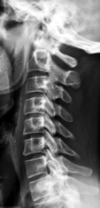Cervical Brachial Neuralgia (CBN) and osteopathy
What is Cervical Brachial Neuralgia or CBN?
Cervical Brachial Neuralgia (CBN) is also called "arm sciatica". Although it is 5 times less frequent than sciatica, this pathology is nevertheless very common.
The NCB translates into a pain felt on the path of the affected nerve. Indeed, cervico-brachial neuralgia is caused by the irritation or the compression of the root of a nerve.
At each vertebral level, two roots (a motor ventral and a sensitive dorsal) emerge from the spinal cord. These roots join together to form what is called the spinal nerve. At the cervical level, there are 8 cervical spinal nerves (from C1 to C8).
In cases of cervicobrachial neuralgia, it is the roots of the lower cervicals and the first dorsal vertebrae that are most affected (C5, C6, C7, C8 roots). In the vast majority of cases, only one side is affected.
Epidemiology of CKD
15 %
This is the percentage of the population affected by BCN.
People over the age of 50 are the most affected by cervicobrachial neuralgia.
Symptoms of CKD
- Cervicalgia (i.e. pain in the cervical region) associated with pain in the path of the nerve root in part or all of the upper limb.
- Possible paresthesias: numbness, burning sensation, and/or tingling of the upper limb
- Decrease or loss of sensitivity in the dermatome related to the root
- Decrease or loss of strength in the motor territory of the affected root
- Decrease or loss of the osteotendinous reflex (OTR) in relation to the affected root
- The pain may be present at rest or during movement. It is present and can be increased at night.
- The pain is increased by sneezing, coughing and sneezing.

Causes of cervicobrachial neuralgia
The causes of cervicobrachial neuralgia are all the causes likely to irritate or compress a spinal root. Examples include:
- Osteoarthritis
- Herniated disc
- Spinal fracture, spinal dislocation
- Tumors: benign or malignant
- Certain neurological conditions such as superingomyelia or neuroma.
Diagnosis and complementary examinations for CKD

The questioning and the tests that your practitioner performs will allow the diagnosis to be made. However, in some cases, additional examinations, prescribed by your doctor, may be useful to determine the cause of the CKD. In general, the first examination performed is an X-ray of the cervical spine (front, profile, three quarters to analyze the foramens).
In the second intention, an MRI or a CT scan can be prescribed to highlight other causes such as a herniated disc.
Treatment of CKD
Osteopathy and cervico-brachial neuralgia

The first objective of your osteopath is to identify your pain. To do this, he or she will ask you questions and perform tests.
If your osteopath wants more information or to identify the cause more precisely, he or she will refer you to your doctor so that you can undergo further tests.
If your osteopath does not identify any absolute contraindications to osteopathic manipulation (for example: fever, a recent fracture, etc.), he will take charge of you. He will then remove all the dysfunctions in relation or at a distance that are likely to cause the pain or to maintain it. He will then work on the neck, the upper back, the upper limbs, but can also work on the pelvis.
In cases of NCB, certain osteopathic techniques are contraindicated. This is the case of joint manipulations such as HVBA (High Velocity Low Amplitude) also called Trust at the level of the cervical vertebrae in direct link with the nerve compression.
This is why it is necessary to consult a well-trained osteopath who will apply all precautions.
During the 45 minutes of the osteopathy consultation, your practitioner will explain to you everything that can cause your pain and thus reassure you.
He will also give you mobilization, stretching or strengthening exercises to prolong the effects of the osteopathy session and prevent your pain from coming back one day.
Finally, it is important to understand that the management of cervicobrachial neuralgia is multidisciplinary and involves the osteopath, other health professionals but also and above all the patient.
Marie Messager
Osteopath D.O
2 rue Alexis de Tocqueville
78000 Versailles
